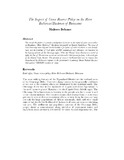Please use this identifier to cite or link to this item:
http://hdl.handle.net/10311/535Full metadata record
| DC Field | Value | Language |
|---|---|---|
| dc.contributor.author | Bolaane, M. | - |
| dc.date.accessioned | 2010-07-08T09:58:43Z | - |
| dc.date.available | 2010-07-08T09:58:43Z | - |
| dc.date.issued | 2004 | - |
| dc.identifier.citation | Bolaane, M. (2004) The impact of Game Reserve policy on the river BaSarwa/Bushmen of Botswana. Social Policy and Administration, Vol. 38, No. 4. pp. 399-417 | en_US |
| dc.identifier.issn | 0144 - 5596 | - |
| dc.identifier.uri | http://hdl.handle.net/10311/535 | - |
| dc.description.abstract | The aim of this paper is to present a background discussion on the impact of game reserve policy on Bugakhwe, “River BaSarwa” (Bushmen/San people) in Eastern Ngamiland. The issues of local community ownership and its relationship to perceptions of what constitutes a rural development, and the problems of land rights, wildlife management and settlement, are important in the booming industry of the Okavango region. When the Moremi Game Reserve was created in 1963, the San of Khwaai were moved out and relocated in their present position, at the north gate of the Moremi Game Reserve. The question of access to traditional land and its resources has characterized the BaSarwa’s response to the government’s Community Based Natural Resource Management (CBNRM) initiative of 1995. | en_US |
| dc.language.iso | en | en_US |
| dc.publisher | Wiley-Blackwell | en_US |
| dc.subject | Land rights | en_US |
| dc.subject | Game reserve policy | en_US |
| dc.subject | River BaSarwa/Bushmen | en_US |
| dc.subject | Botswana | en_US |
| dc.title | The impact of Game Reserve policy on the river BaSarwa/Bushmen of Botswana | en_US |
| dc.type | Published Article | en_US |
| Appears in Collections: | Research articles (Dept of History) | |
Files in This Item:
| File | Description | Size | Format | |
|---|---|---|---|---|
| Bolaane_SPA_2004.pdf | 2 MB | Adobe PDF |  View/Open |
Items in DSpace are protected by copyright, with all rights reserved, unless otherwise indicated.
